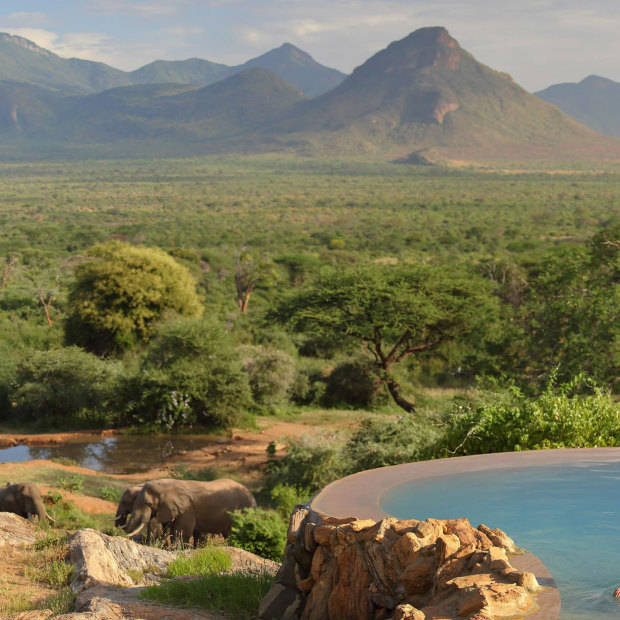
Kenya’s Sarara Camp, an amphitheatre made of craggy mountains clustered around vast sunlit plains.
Heaven is a place on Earth. We know that because Belinda Carlisle, the American songstress, with her eponymous hit single from 1987 told us so.
However, many of us already knew that heaven is a place on Earth - defined as “a feeling of bliss or paradise that can be found in the present moment or in a particular place or experience” – based on our most unforgettable and profoundly affecting travels.
But, where on Earth, exactly, if you had to pinpoint it, truly deserves such an ethereal title and why? While Carlisle, in truth, was actually thinking, despite her song title, of an act rather than a place, it’s the question of a geographic nature that we posed to seven of Traveller’s experts.
Here, in an eclectic list proving that heaven doesn’t have to be a desert idyll, are their choices.
Great expectations fulfilled
By Rob McFarland
I arrive in Palau with alarmingly high expectations. After all, this is a country that declares itself a “pristine paradise”; a place that has set numerous environmental precedents, including voting in the world’s first nuclear-free constitution, creating the first shark sanctuary and becoming the first nation to ban reef-toxic sunscreens.
Passing through immigration following a new Air Niugini flight from Brisbane, it’s now more accessible than ever.
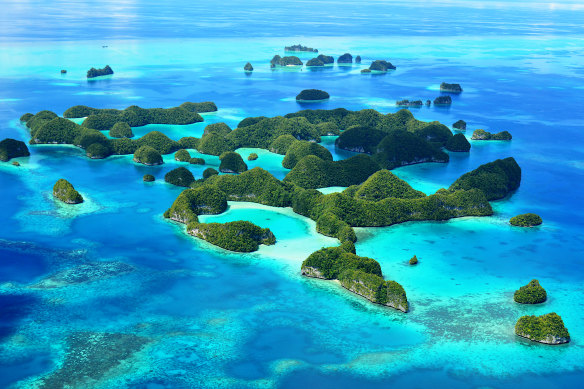
The lagoon-rimmed Seventy Islands are part of the UNESCO heritage-listed Rock Islands, Palau.Credit: iStock
I’m asked to sign the Palau Pledge, a solemn oath stamped in my passport that I will protect the country’s natural environment and preserve its local traditions (another world first).
It’s big talk for one of the planet’s smallest and most remote nations, an archipelago of about 340 jungle-smothered islands near the Philippines in the Western Pacific.
Let’s face it – it’s one thing to claim that you’re a “pristine paradise”; it’s another thing to deliver.
But Palau has got this. It’s faced this sort of cynical scepticism before, and it’s got a trump card: the Rock Islands, a UNESCO World Heritage-listed medley of verdant limestone outcrops surrounded by aquamarine water that’s so preposterously photogenic I’m surprised it’s not Microsoft’s default screensaver.
And so begins a week-long courtship. It starts with a snorkelling trip, where we drift over fields of vibrant coral swarming with harlequin reef fish.
Next is a diving excursion to what many claim are some of the world’s best dive sites – an assortment of coral plateaus, man-made channels, World War II wrecks and plunging drop-offs frequented by grey reef sharks, hawksbill turtles and manta rays.
Then it’s a kayak tour into secluded bays flanked by soaring, jungle-covered cliffs to see baby blacktip reef sharks and ghostly moon jellyfish.
Finally, just to seal the deal, there’s a scenic flight in a doorless Cessna over the entire country, which, from above, resembles what I suspect an AI image generator would produce if given the prompt “pristine paradise”.
But there’s more. Underneath Palau’s supermodel looks is an intriguing culture that dates back three millennia. It’s a matrilineal and matriarchal society where women choose the chiefs and control the finances.
It’s also a nation with a jungle interior that conceals rusted World War II tanks, unexplained ancient monoliths and mysterious sculpted hills.
This is a place where spirits are worshipped, fruit bat soup is a delicacy and traditional customs, including money bracelets and a gruelling first-born bathing ceremony, still endure.
See pristineparadisepalau.com; airniugini.com.pg
In the land of wildlife lullabies
By Sue Wiiliams
I’m in a remote area of northern Kenya, the ancient lands of the Samburu people, in the pristine 3500-square-kilometre wildlife conservancy of Namunyak by the magnificent Mathews Range mountains.
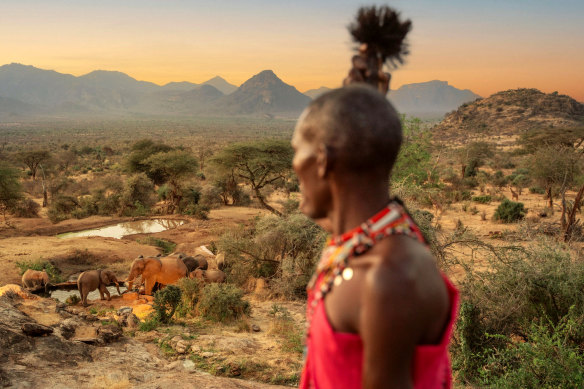
Water stop … the Sarara Camp.
Many here still live a traditional lifestyle, caring for their cattle while also protecting wildlife.
One of the most incredible sights any traveller can witness – and it’s so closely guarded that no photographs have ever been allowed to be taken – is of these people at their legendary Singing Wells.
By these deep, hand-dug boreholes in the early morning dust in one of the world’s most inhospitable landscapes, they sing their own distinctive lullabies to their cattle, encouraging them to drink the water they’ve scooped out via a chain of young men, while warning leopards to keep away.
Then the afternoons belong to those leopards, as well as the area’s lions, elephants and zebras, as they take their turn to drink, an arrangement that has existed since the beginning of time.
Dazzled by the experience, this heaven on Earth continues when we are driven a short distance away to the Sarara Camp.
Comprising six luxury glamping tents, its piece de resistance is a spectacular swimming pool overlooking the waterhole where the rest of the animal kingdom come to drink, in an amphitheatre made of craggy mountains clustered around vast sunlit plains.
The Namunyak sanctuary is Kenya’s best-untouched wilderness along its northern frontier and is also the home of one of the world’s most successful community conservation movements, where the Samburu also work to protect the wildlife from the inevitable incursions of poachers.
As a result, it has become a treasure trove of creatures great and small, some of them rare and formerly endangered, as well as a showcase of an age-old way of life, a source of huge pride for the local people.
When you’re here, you can’t help but be awestruck by such a pure slice of life and the mutual respect between the human and animal kingdoms. And when you’re back, you can’t help but be haunted by the vision. See classicsafaricompany.com.au
Cherry blossoms in the Big Apple
By Kristie Kellahan
I sit in the shade of a cherry blossom tree in Central Park, its branches filled with thousands of delicate pink flowers in ecstatic full bloom. A light breeze coaxes a few petals to the ground. Like nature’s confetti, they gently land on my shoulders, my jeans, the top of my head.
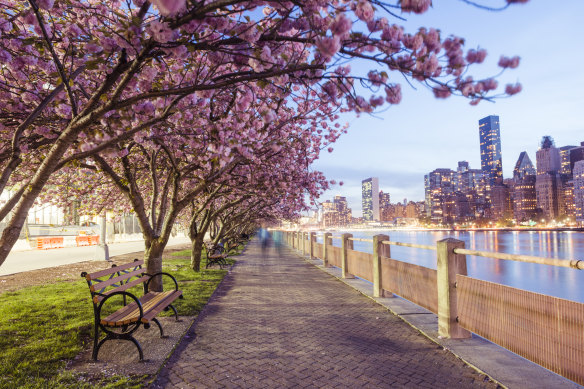
Roosevelt Island in bloom.Credit: iStock
There’s not a cloud in the April blue-bird sky, the sun shines brightly, and the air is crisp. This New York minute is heaven on Earth, treasured all the more for its impermanence.
Heralding the end of winter, the beautiful, yet fleeting, buds burst onto the stage for a few dazzling days, reminding us of the power of renewal and nature’s resilience, urging us to live fully in the present.
Soon enough the petals will shed, revealing sturdy new green leaves. Sweaty summer days in the city will arrive.
For one month every year, my obsession with the ephemeral beauty of cherry blossoms is all-consuming. I have planned entire itineraries around the predicted peak bloom in Paris, Washington DC, Japan and South Korea, changing flights at the last minute so as not to endure the crushing blow of disappointment in arriving a few days too early or late.
Those places are all captivating destinations for flower nerds, but none is more magnificent than New York City.
Walk under a canopy of pink perfection on the west side of the Jackie O Reservoir in Central Park or along the Roosevelt Island waterfront on a bright, sunny day and you’ll be hard-pressed to name a more beautiful sight in the world.
The bloom of Brooklyn Botanic Garden’s majestic corridor of more than 80 Kwanzan cherry trees is so eagerly anticipated, a Cherrywatch feature was added to their website several years ago.
Every morning, starting in early spring, a staffer is tasked with walking around the garden to take note of each tree’s status: pre-bloom, first bloom, peak bloom or post-peak bloom. Results are loaded daily to an online map. I’ve refreshed the page more times than I can count.
When I shuffle off this mortal coil, my family might endow one of Central Park’s 10,000 benches with a plaque. I wonder which quote they’ll choose.
Perhaps they’ll lean towards the philosophical – Hal Borland’s “No winter lasts forever; no spring skips its turn” – or they’ll embrace the passionate words of Pablo Neruda: “I want to do with you what spring does with cherry trees.”
It won’t matter to me, will it? I’ll be gone, like a cherry blossom flower on the wind.
See bbg.org, centralparknyc.org
Behold, the nearest point to paradise
By Katrina Lobley
You don’t expect to see some things with your own eyeballs. For me, that thing was Mount Everest.
I’m a middle-aged woman of so-so fitness, hardly a mountaineer. In fact, full disclosure: I hate schlepping uphill. The thing I do like, though, is tackling an unexpected adventure. So several years ago, I surprised myself: I said yes to a trek in Nepal.
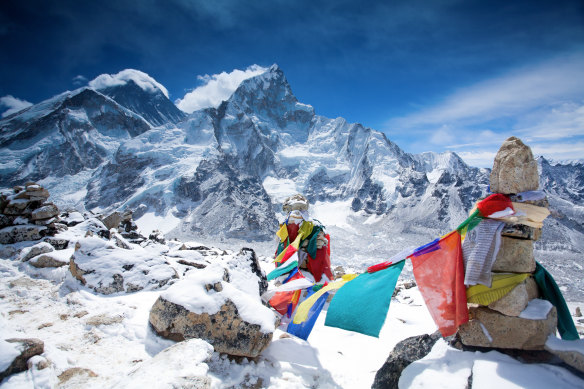
Prayer flags on top of the mountain Kala Pattar in Nepal.Credit: iStock
After one of the most heart-stopping landings you could ever experience (anyone who’s dropped down onto Lukla’s uphill-angled airstrip will know what I mean), we breakfast then start climbing to Namche Bazaar. Sherpas lighten our load, making it easy for our group to make good progress.
I watch in amazement when the Sherpas run ahead as though the air isn’t thin, the path not uneven and the climb unrelenting.
We stop regularly to rest, rehydrate and refuel, listening out for the passing beasts of burden who wear warning bells.
As I duck around the carved and painted prayer stones known as mani, I keep pinching myself that I’m not only here but keeping up.
We spot Everest along the way. I’d expected the highest point on our planet to stand alone and stand out – to look like a majestic, almost-unconquerable beacon that calls some humans to its treacherous slopes.
Instead, our guide must point out which of the distant Himalayan peaks is the one topping out at 8848 metres. I stare, unblinking, burning every facet into memory.
The hikers’ hub of Namche Bazaar, perched at an elevation of 3440 metres, proves high enough for me.
From here, we undertake (literally) breathtaking side-trips. We venture a little closer to Everest Base Camp and wander through improbable rhododendron forests.
One day, as tiny hailstones pelted down, our guide went to slip a rain poncho over me. My nose was running uncontrollably; I was too tired to care. He simply slid his forefinger beneath my nose, wiping it for me. This little kindness sums up Nepal.
For us it’s all ups, no downs, in every sense: we return to Lukla as planned by helicopter. When I later post that I’d choppered past Everest, that almost mythological mountain, a friend asks if I’d been medi-vacced.
Cute, buddy, but I understand the wonder behind the question. If I, of all people, could almost reach out and touch the closest earthly point to heaven, it must mean that anyone can. See ntb.gov.np
Of hot Turkish tea and sesame simit
By Belinda Jackson
The cool, damp fingers of the evening’s mist linger in the vales about little Sirince, a village on Turkey’s Aegean coast.
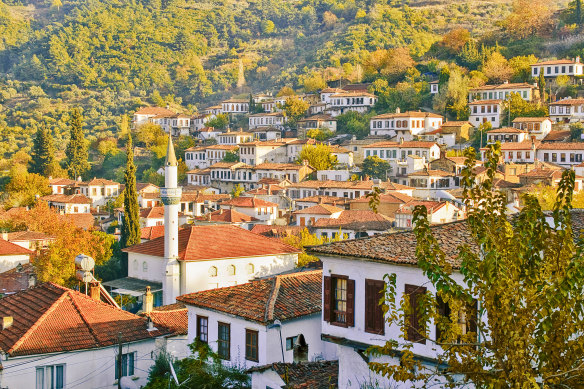
The beautiful hill town of Sirincet, Turkey.Credit: iStock
In a previous lifetime, Sirince was one of hundreds of Greek villages up and down the coastline that were abandoned after the devastating population exchange in 1923 following the collapse of the Ottoman Empire and the Greco-Turkish War.
I’ve spent the day beneath the hot, Mediterranean sun, walking the marbled streets of Turkey’s archaeological jewel, Ephesus, but Sirince now provides welcome relief from the heat. My footfall is muffled by the mist as I climb a steep, cobbled lane up to Nisanyan House Hotel.
Nisanyan was a stone house, forgotten or ignored for generations and demoted to a lowly stable before its reincarnation into a small, family hotel.
Now, the hotel is its own village; a series of hand made, whitewash-and-stone cottages, inns and villas along the tree-lined laneway.
The windows are shuttered as the sun falls and the moon rises; nights here are cool and silent, save the toll of a goat’s bell and the final call to prayer from a mosque down in the valley.
In my cottage, deep red rugs are thrown over stone floors, hand-stitched coverlets and cushions adorn well-worn armchairs and my daybed, where I languish, the bells and the muezzin’s voice carried to me on the jasmine-scented night air.
In the fresh light of a new day, I take my seat in a hillside gazebo as the morning sun pours into the vales, the mist lifting to reveal layers of wooded ridges about me.
There is no breakfast like a Turkish breakfast: my table is laden with plates of sliced deep red tomatoes and cold cucumber, freshly boiled eggs and soft handmade cheeses garnished with thyme.
The tea is hot and reassuringly “tavsan kanı” – the deep red colour of rabbit’s blood – as all good Turkish tea should be. A basket of crusty loaves and sesame-sprinkled simit – a prettily knotted bread – accompanies pots of handmade sour cherry jam and honey from nearby hives.
Glossy olives twirl and bob in their own oil, thick, fragrant and grass green, wrought from the groves that hem my little hotel. See nisanyan.com, intrepidtravel.com
From chanting monks to chattering monkeys
By Lee Tulloch
There’s a little piece of paradise on the south coast of Sri Lanka near Tangalle, reached by an unmade road that runs between a quiet lagoon and an unspoiled stretch of the Indian Ocean.
Chanting from a nearby Buddhist temple and the chattering of langur monkeys form the soundtrack. On the lagoon side there is a tangle of jungle; on the ocean side there are palm trees and plots of land, dotted with rustic ayurvedic retreats, small bars and simple houses.
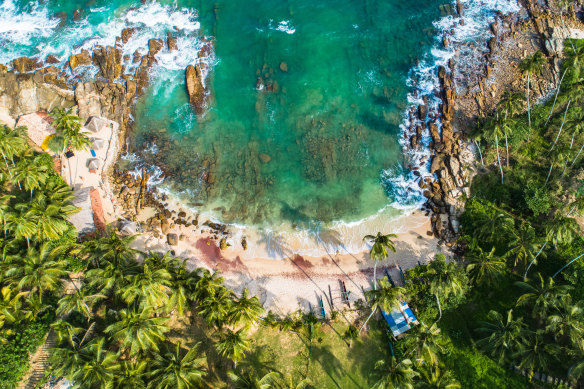
Goyambokka beach, Tangalle, Sri Lanka.Credit: iStock
Many of the beachfront lots are undeveloped, and cattle and goats graze under the trees. It seems impossible that somewhere so beautiful remains relatively undiscovered. There aren’t any noisy pubs or big hotel complexes on this strip of coast. The closest village is kilometres away.
The properties sit on Rekawa Beach, a kilometres-long stretch of pale sand that is the domain of local fisherman, turtles, dogs, surfers and the occasional beachcomber.
I may never have known about this lovely strip of coast if I hadn’t been invited to stay last year at Kayaam House, an eight-bedroom villa and wellness retreat which opened in 2022 by Reverie, the lifestyle arm of the Dilmah tea company.
Hidden behind a high stone wall on the unmade road, the beautiful colonial style house was built to be the residence of a prominent local family.
It functions like a private villa more than a hotel, where guests are encouraged to follow their own inclinations about when to eat (astoundingly good Sri Lankan cooking), when to spa, swim, surf or cycle.
The house is a dream – a romantic four-poster bed draped in mosquito nets; a sea-view bath on my long verandah; a garden yoga Shala where I take classes alone; cool hallways with internal waterfalls and koi ponds.
Then there are the planter’s chairs on the back terrace with views to the tranquil countryside and poolside lounges by the gorgeous garden-set pool where I swim in sync with the surf’s pull. Plus cycling along shady lanes where the only traffic are monkeys.
Kayaam House truly tips the divine scale but even if it wasn’t there, you could find me in a little shack under a palm tree and I’d be happy. It’s magical – and I didn’t tell you about it, right?
See thereverie.life
Aspen with the altitude, not the attitude
By Craig Tansley
These days Telluride attracts the likes of Oprah Winfrey and Tom Cruise, but that’s never been what coming here has been about to me (though I do dream of running into another resident, rock legend, Neil Young who shares a place here with partner, Daryl Hannah).
Telluride – a south-western Colorado ski town near the border with Utah – feels entirely separated from the rest of my world. And I like that.
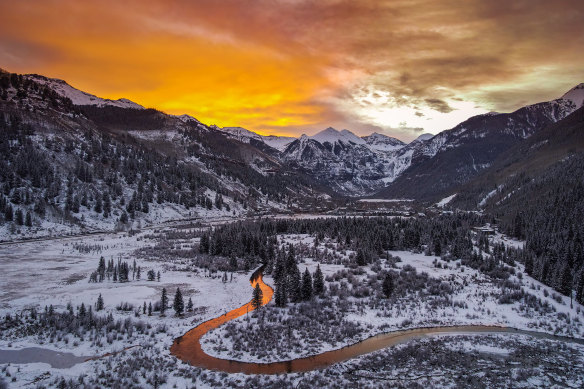
Telluride is surrounded by more tall mountains than any other destination in the US.Credit: Telluride Tourism
Anything that’s going on in my life isn’t going on when I come to Telluride. Mountains form natural barriers – just like walls around castles – and Telluride is the safest castle of them all.
Located at the end of a box canyon (a canyon closed entirely by vertical walls), once you make it here, there’s no way out but the way you came in.
Tall mountains can be humbling things: they can make me feel big and small all at the same time; and Telluride is surrounded by more tall mountains (over 14,000 feet, by the US measure, or 4267 metres) than any other destination in the US.
Ski towns can begin to look the same when you visit enough of them. But not Telluride. It was built in the years following the Colorado Gold Rush (of the 1850s), and nothing much has changed since.
There’s an old clock tower from 1887 in its main street, the streets are wide enough for a horse-and-cart to turn around on, and the bank Butch Cassidy robbed in 1889 (it was his first, and most brazen robbery, and afterwards he walked three blocks tipping his hats to locals) is still standing.
Some bars in towns still have mirrors placed behind the server, so you can see if the cowboy behind you is going to pull his pistol. They sure don’t have bars like that in Perisher or Hotham.
It’s fancy: the restaurants and hotels here are every bit as chic as anything you’ll find in Aspen.
But at the same time, there are many local bars selling happy-hour beers for $5. And Telluride isn’t just a ski village like Vail or Whistler; it’s a real town, with real locals, some of them go back five or six generations. I’ve been coming since 2004; I’m starting to feel like a local too.
When I ride the gondola from the mountain-top village to the old town below as the evening alpenglow turns the mountains rosy-red, there’s nowhere on Earth I’d rather be. See telluride.com
Seven more heavens on Earth
Espiritu Santo, Vanuatu
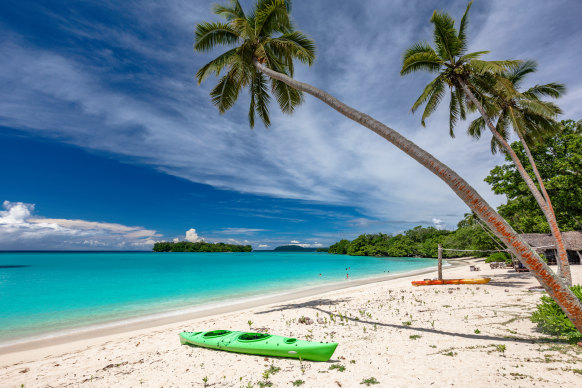
Port Orly Beach on Espiritu Santo Island.Credit: iStock
Vanuatu’s largest island feels like hardly anyone’s seen it, locals still live subsistence lifestyles, while wild jungle growing along huge mountain ranges dominates the landscape. But you’ll find some of the best beaches of the South Pacific here, and eco-retreats built beside them, offering world-class diving, including one of the world’s best shipwreck dives. See vanuatu.travel
Siwa Oasis, Egypt
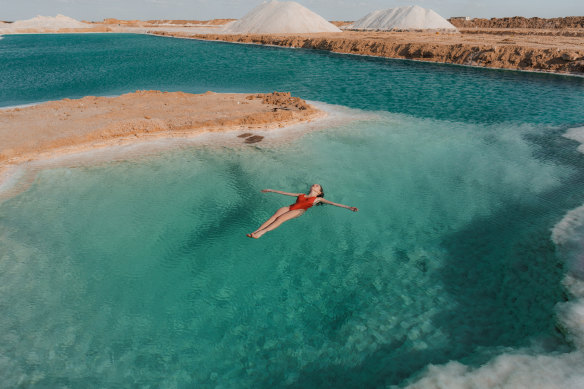
Swim in salt lakes at Siwa Oasis.Credit: iStock
It may be remote – on the edge of the Great Sand Sea and close to the Egypt-Libya border – but Siwa’s log of visitors can’t fail to impress; Alexander the Great came to consult the Oracle of Amun in 332AD as part of his campaign to rule this rich land. Remnants of the oracle’s now-ruined temple remain on the oasis’ edge, and this mud-brick town still marches to the beat of the Bedouin tribes who settled here. See experienceegypt.eg
Kodiak Island, Alaska, US
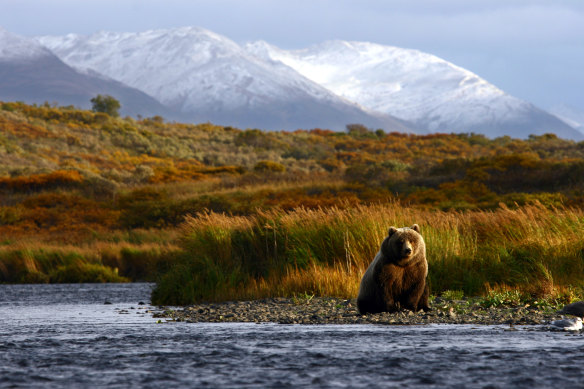
See brown bears on Kodiak Island in Alaska.Credit: iStock
Kodiak, the US’s second-largest island, is home to large brown bears, intriguing Russian history, moss-floored forests, fast-flitting puffins and fresh fish dinners. Put yourself in the middle of Alaska’s Emerald Isle by catching a float plane to Kodiak Brown Bear Centre and Lodge, which specialises in bear-viewing experiences. See kodiakbearcenter.com
Samoa
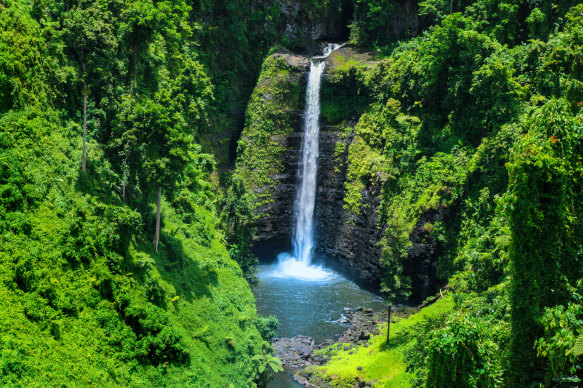
Waterfalls, white sand beaches and rainforests await in Samoa.Credit: iStock
Everything’s perfect in these, the most traditional islands of Polynesia. There’s no rubbish, locals sleep for a fair proportion of each day and live in villages by the sea in huts with no walls (or locks). Full of waterfalls, white-sand beaches, rainforest and surrounded by the Pacific at its prettiest, Samoa is that place you dreamed the South Pacific would be. See samoa.travel
Wadi Rum and Petra, Jordan
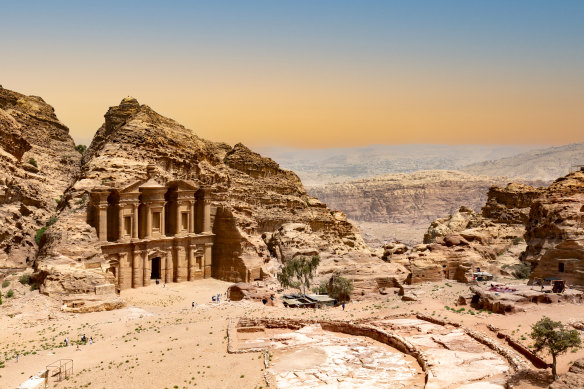
The Monastery in Petra, Jordan.Credit: iStock
A rose-tinged desert flanked by majestic cliffs on either side, close to one of the great ancient wonders of the world. What could be more heavenly than spending a couple of days in Jordan’s Wadi Rum desert, with star-blazoned nights in a Bedouin camp, followed by two days wandering, awestruck, through the pink city of Petra and its startling rock-hewn architecture? See visitjordan.com
Grand Canyon, US
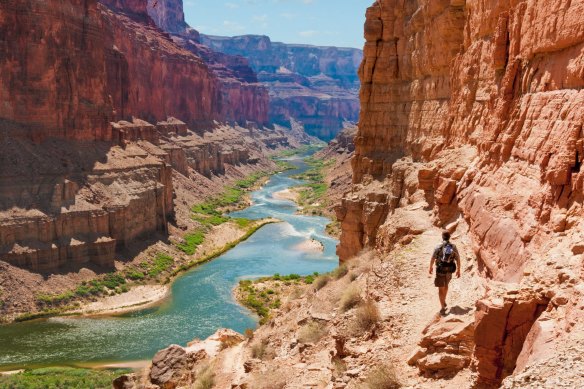
Nothing beats the Grand Canyon.
There are deeper, wider and longer canyons, but for sheer, conversation-stopping majesty, nothing comes close to this one. Whether you hike into it, fly over it, raft through it or just gawp at it, you’ll never forget the first time you see this dramatic, 446-kilometre snaking chasm, a plunging abyss that in places yawns to 29 kilometres wide and has blushing rock walls that provide a unique 1.8-billion-year geological snapshot. See nps.gov
Aitutaki, Cook Islands
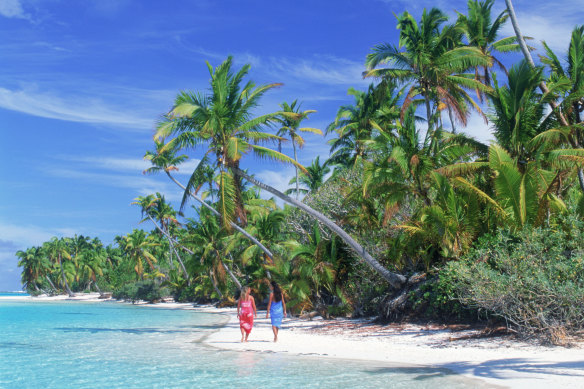
Aitutaki: The best lagoon in the South Pacific.Credit: Alamy
Located 45 minutes’ flying time from Cook Islands’ capital, Rarotonga, Aitutaki is home to the South Pacific’s best lagoon. At 74 square kilometres, it’s four times the size of Aitutaki itself, but the best part is there are 15 tiny islands (motu) and all but one of them are completely uninhabited. Take a boat trip across the lagoon and find a motu for yourself. See cookislands.travel